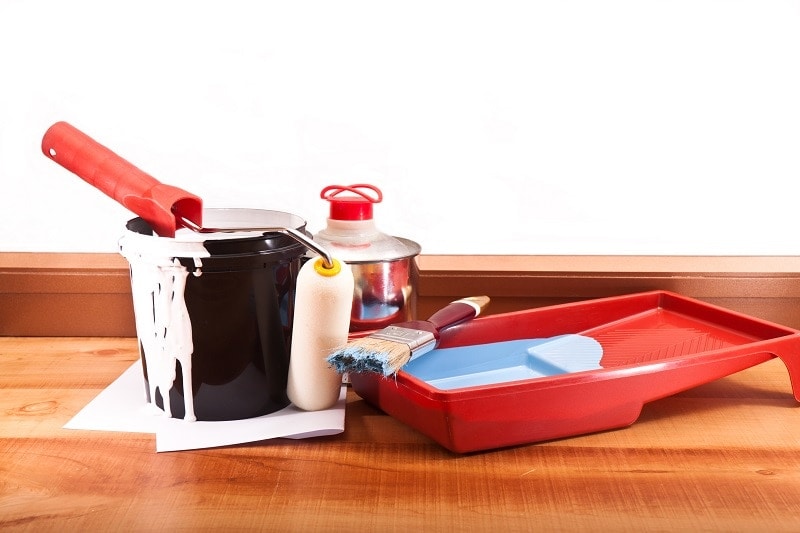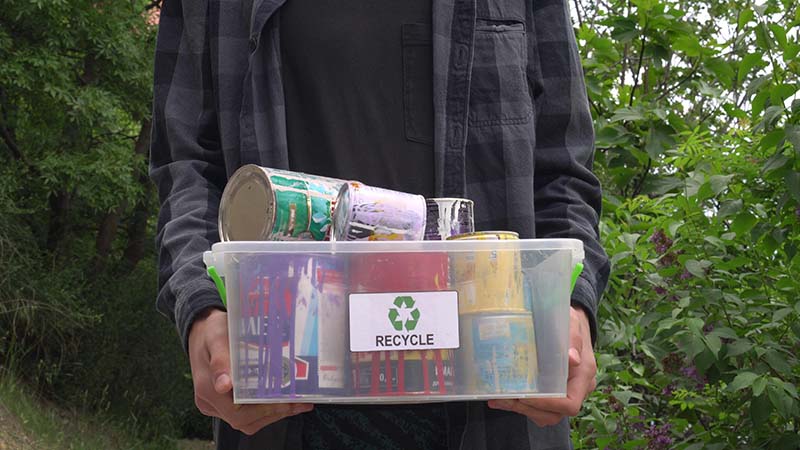Can You Pour Paint Thinner Down the Drain? Hazards & Disposal Tips
-
Pete Ortiz
- Last updated:

Paint thinner is indispensable to the average artist needing solutions for dirty brushes, but this handy cleaner can create new problems when it’s time to toss it. The volatile solvents in thinners are extremely hazardous to people and the environment. Pouring them down the drain can damage plumbing and contaminate the groundwater, presenting an immediate safety and environmental risk that could lead to hefty fines alongside severe health issues.
The convenience of tossing it in the kitchen sink may be prohibited, but you can still enjoy the benefits of paint thinner during your projects without worrying about how you’ll get rid of it. We’ll discuss why you can’t pour paint thinner down the drain and offer solutions for safe, sensible, and convenient disposal.
Can You Pour Paint Thinner Down the Drain?
Paint thinner must NEVER go down the drain or into the gutter because of the pollution risk. The toxic compounds in many solvents can damage local ecosystems and potentially recirculate into local water supplies.
If you have a septic system, paint thinner will damage the beneficial bacteria populations in the tank, hindering their ability to break down waste. The chemicals will then mix with effluent and enter the drain field, where they can contaminate the soil and groundwater.
When you have accumulated enough leftover paint thinner from your various projects, take it directly to a hazardous waste disposal site for safe removal. Due to the threat to people and wildlife, many municipalities regard paint thinners as hazardous substances. If you pour solvent down the drain, you could face substantial penalties for improper disposal, including thousands of dollars in fines and several years of jail time.

What’s In Paint Thinner?
Paint thinner is a solvent, typically consisting of mineral spirits, that thins a paint’s consistency for smoother application and strips leftover oil-based paints from brushes, rollers, tools, and other surfaces. Other popular substances that work well as paint thinners include:
- Turpentine
- Naphtha
- Isopropyl alcohol
- Acetone
- Methyl ethyl ketone (MEK)
- Dimethylformamide (DMF)
- 2-Butoxyethanol
- Xylene
- Toluene
- Glycol ethers
Mineral spirits are petroleum distillate products consisting of hydrocarbons. They are less volatile, flammable, and toxic than other paint thinner options. Some less refined solvents, such as naphtha, come from petroleum distillates, while others derive from alcohols, like ethyl, methyl, or isopropyl alcohol. Turpentine, a popular thinner and cleaner for dried paint, is unique in that it stems from pine tree resin.
Hazards of Working with Paint Thinner
Paint thinner is highly corrosive and flammable, whether made of mineral spirits or another substance. Toxicity varies, but nearly every paint-thinning solvent emits volatile organic compounds (VOCs).
Working with proper protective gear in a well-ventilated environment is crucial to prevent the litany of health effects you may suffer from short-term exposure to paint thinner vapors, including:
- Dizziness
- Headaches
- Shortness of breath
- Fatigue
- Nausea
- Allergic reactions
- Eye, nose, and skin irritation
Long-term and repeated exposure may incur more severe consequences, including chronic neurological, renal, and respiratory disorders, while overexposure at one time can be fatal.
As a more immediate hazard, most paint thinners are also flammable. Mineral spirits can ignite at only 104°F, while turpentine’s flash point is even lower at roughly 95°F and acetone a mere -4°F. At these temperatures, paint thinner vapors can mix with air and ignite from an external flame source, making them hazardous in an area with sparks or open flames.

How Do You Dispose of Paint Thinner?
You may not be able to pitch paint thinner down the drain, but that doesn’t mean there aren’t convenient and safe ways to get rid of used or unneeded solvents at the end of a painting project. Depending on how much you are discarding, you may be able to get rid of your old paint thinner in the trash or by taking it to a waste disposal site.
No matter how you throw it away, you can take the most efficient and worthwhile approach with a sustainable focus. Reducing the amount you use, reusing what you can, and recycling the rest is the best way to manage paint thinner. Here’s how you can use and dispose of your old solvent responsibly.
Discard Old Containers & Materials
Old paint thinner cans must be completely dry before you can toss them in the trash. If there is more than an inch of dried residue in the container, or if liquid is still in the bottom, consult your local waste collection service for instructions on where to take it.
Due to the fire hazard, used rags and other materials holding significant amounts of paint thinner must also go to the proper waste disposal facility. Store soaked rags in a sealable metal container, and cover them in water. Alternatively, you can dry the rags in a well-ventilated area and keep them in a fire-safe container until you can dispose of them.

Take Used or Unused Paint Thinner to a Waste Disposal Facility
You can take large amounts of paint thinner to an appropriate disposal site. You can find a hazardous waste disposal facility near you with a simple web search for your area. For convenience, the EPA provides a helpful locator tool for solid and hazardous waste disposal programs across the country.
County governments provide information on the best way to dispose of paint thinner on their websites or via phone. Municipalities also often host pickup events throughout the year specifically for the hazardous waste you can’t discard in the trash. Contact your local service to discuss the correct container and procedure for disposal.
Other Options to Get Rid of Old Paint Thinner
If going to a waste disposal center is inconvenient, you may still have plenty of alternate options to discard old paint thinner. Ask neighbors, family members, and friends to see if anyone could use some free solvent. Local organizations may also take it off your hands for future projects, and you can check with gas stations and auto shops that can often use it.
What Do I Do If I Pour Paint Thinner Down the Drain?
A little paint thinner typically won’t cause lasting damage to your pipes or the environment. If you accidentally pour some down the sink, run hot water and dish soap in it for about 5–10 minutes. The soap will emulsify the oily solvent in the water and flush it out of the system, which removes the paint-thinner smell with it.
How To Reuse Paint Thinner
Paint thinner may not be great for your health or the environment, but it’s hard to beat when trying to salvage your painting tools for another use. Fortunately, you can usually reuse your paint thinner if you have to resort to it during your next painting project. Instead of ditching it after one use, follow these tips for extracting fresh fluid from spent solvent:
- 1. Put on rubber gloves & a mask
- 2. Soak your brushes with solvent in a small metal container until clean
- 3. Remove the tools slowly to prevent stirring up the paint thinner
- 4. Let the paint thinner sit for several hours (or even a few days) until the particles settle
- 5. Carefully pour the clean paint thinner on top into a second tightly sealed container
- 6. Label each container of dirty & fresh thinner accordingly
- 7. Leave the waste container open in a well-ventilated area away from people and pets to dry out (add kitty litter or sawdust to help it dry faster)
- 8. Once dry, seal the container and if there is less than an inch of sludge in the bottom, throw it in the garbage can
Paint thinner can take several days or even weeks to separate. Rather than wait, you can recycle a batch of solvent in minutes by filtering the used liquid through 2–3 layers of coffee filters. The filters will catch any particles regardless of whether the fluid is settled, leaving nothing but fresh, clean thinner.
You can also reuse the waste container for future rounds of brush cleaning and dispose of it when it’s full. If there is more than an inch of sludge in the container, you must take it to a hazardous waste disposal facility. Keep both containers of old and unused thinner in a safe area away from heat where your children and pets can’t reach.

Final Thoughts
Accidental solvent spills in the sink shouldn’t make you lose sleep, but making a habit of pouring paint thinner down the drain is negligent. The risk to household health, the environment, and your neighbors’ safety demands attention and extra care. Use paint thinner conservatively, and follow these essential guidelines to ensure you take the conscientious route when discarding your hazardous leftovers.
Featured Image Credit: TaurusY, shutterstock
Contents


